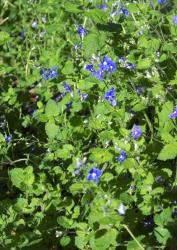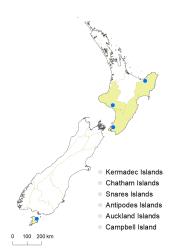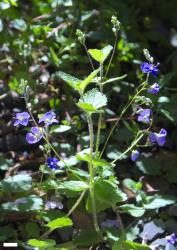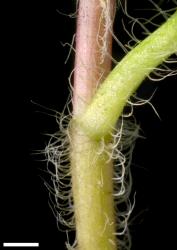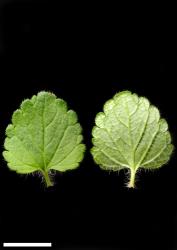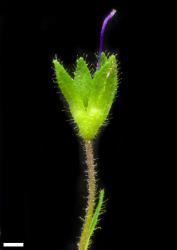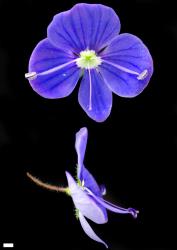Spreading, loose mat-forming or sprawling herb to 0.3 m tall. Stems decumbent to ascending, eglandular-pubescent; hairs bifarious, sometimes a few scattered hairs between the rows. Leaf bud indistinct; leaves separating while small, opposite-decussate, erecto-patent to spreading; lamina thin, ovate, elliptic, or ovate-deltoid, 8–35 mm long, 8–25 mm wide, dull, green to dark green above, pale green beneath; midrib and secondary veins evident; surfaces sparsely hairy or becoming glabrous above, moderately hairy especially on veins beneath; margin ciliate, bluntly serrate or crenate-serrate; teeth in 4–10 pairs; apex obtuse to rounded; base truncate to sub-cordate; petiole 1.5–7.0 mm long. Inflorescence a lateral raceme, 50–150 mm long; flowers distant, 5–15, all bisexual; bracts alternate, linear to narrowly elliptic, < pedicels; pedicels erecto-patent to spreading, 5–10 mm long, eglandular-hairy all around, with a few glandular hairs. Calyx lobes 4, sub-acute to acute, 2.5–3.0 mm long at flowering, elongating later to 4 mm long, sub-equal, with long glandular and a few eglandular hairs on faces, mixed glandular- and eglandular-ciliate on margins. Corolla 10–14 mm diameter; tube white and yellowish, 0.5–1.0 mm long, < calyx, eglandular-hairy inside; lobes 4, blue to purplish, spreading, sub-equal, broadly elliptic, ovate, obovate, or orbicular, 4.5–6.5 mm long, rounded; nectar guides dark blue. Stamen filaments purplish, 3.5–5.0 mm long; anthers blue or purple. Style glabrous, 4–5 mm long. Capsules and seeds not seen in New Zealand material.
V. chamaedrys plants are vegetatively similar to those of several other species in leaf size, shape, and toothing. The flowers are in lateral racemes, rather like those of native species such as V. lanceolata, which, however, have thicker leaves and usually white flowers that often have the lateral corolla lobes longitudinally folded.
V. arvensis plants have terminal inflorescences of very small sub-sessile flowers.
V. persica plants can be distinguished by terminal inflorescences with large, leaf-like bracts, much shorter style and stamens, pale anterior corolla lobes, and by forming capsules, which are broader than long.
V. javanica plants have very much smaller and cleistogamic flowers, and the inflorescence elongates at fruiting rather than before flowering. V. calycina and V. plebeia are similar, but their leaves have shorter hairs. V. plebeia leaves are more sharply toothed, stems have much shorter hairs, and the corolla is shorter than the calyx.
V. umbrosa plants have similar growth form, inflorescences, and large blue flowers. V. umbrosa is commonly cultivated, often as V. peduncularis, V. ‘Georgia Blue’, or V. ‘Oxford Blue’ (Albach 2006). The plants are distinguished by their reddish stems with very short, recurved, bifarious hairs, and leaves that are lanceolate, cuneate at base, and glabrous on surfaces with a few short bristles on the margins. Their capsules and seeds also distinguish them (Albach 2006), but capsules have not been seen in either species in New Zealand.
North Island: Gisborne (Toatoa), Taranaki (near Rangitatau), southern North Island (Trentham).
Stewart I. (Halfmoon Bay).
In the South Island, V. chamaedrys has been collected from gardens in Nelson and Christchurch, but was probably not naturalised there.
Roadsides, stream-sides, forest margins, probably an escape from cultivation. Recorded elevations range from 40 to 530 m.
Indigenous to temperate Eurasia.
Healy (1957, p. 650–651). Voucher CHR 78751, Healy, Barton’s Bush, Hutt Valley. An earlier record (Thomson 1875) was based on a specimen of V. persica.
Flowers: September–November; fruits: not seen in New Zealand.
2n = 32 in Europe (Albach et al. 2008).
Veronica chamaedrys is classified in V. subg. Chamaedrys (Albach et al. 2004; Albach & Meudt 2010).
The hairs on stems and leaves are long, slender, and tapering, and between 0.5 and 1 mm long.
V. chamaedrys plants are self-sterile and fruits and seeds have not been observed in New Zealand.



